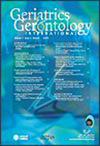Features of sarcopenic obesity in rheumatoid arthritis patients
Abstract
Aim
The present study aimed to determine the proportion of rheumatoid arthritis (RA) patients with sarcopenic obesity and to identify associated factors through assessments of physical function and patient-reported outcomes (PROs).
Methods
A prospective cohort study of 321 RA patients aged 40–79 years was conducted. Participants were classified into four groups—Normal, Obesity, Sarcopenia, and Sarcopenic obesity—based on sarcopenia criteria, which included skeletal muscle mass index, grip strength, and physical function, as well as obesity criteria defined by body fat percentage. Baseline characteristics were analyzed, including evaluations of physical function, such as the Timed Up and Go (TUG) test, as well as PROs, such as the Health Assessment Questionnaire – Disability Index (HAQ-DI).
Results
Sarcopenia was found in 19.6% of participants. Proportions of participants by group were as follows: Normal, 28.7%; Obesity, 51.7%; Sarcopenia, 11.2%; and Sarcopenic obesity, 8.4%. The median disease activity score suggested that remission was achieved in all groups. The TUG and HAQ-DI scores were highest in the Sarcopenic obesity group, showing a significant difference compared with all other groups. Other physical function assessments and PROs were also worse in the Sarcopenic obesity group compared with all other groups.
Conclusions
The proportion of sarcopenic obesity in the present study population of well-controlled RA patients was 8.4%. The Sarcopenic obesity group had significantly higher scores in TUG and HAQ-DI compared with all other groups. We observed not only reduced physical function but also a notable decline in quality of life, as evaluated by PROs, in patients with sarcopenic obesity. Geriatr Gerontol Int 2025; 25: 1323–1331.


 求助内容:
求助内容: 应助结果提醒方式:
应助结果提醒方式:


